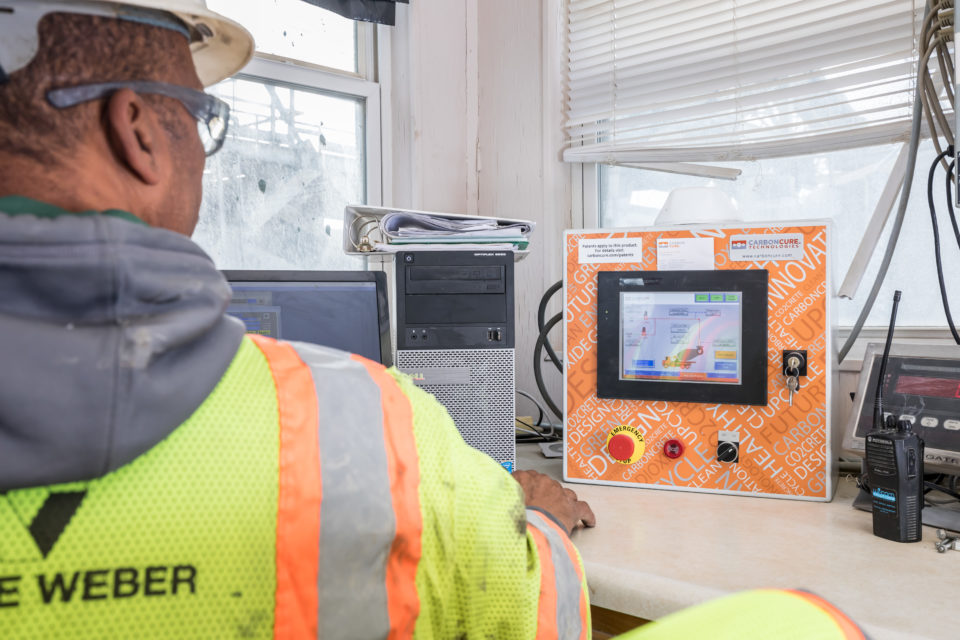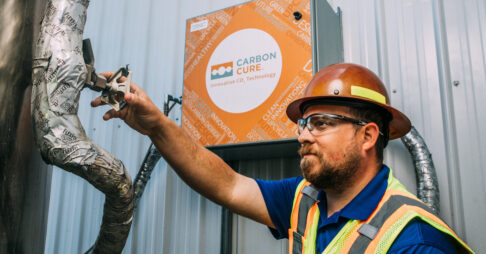In order for the business sector to make a meaningful climate impact and help the world meet the goals of the Paris Agreement, it is imperative to ensure the integrity of corporate greenhouse gas accounting and carbon credit transactions.
At CarbonCure, we recognize that carbon credit buyers and the companies, organizations and institutions who use our concrete want to be sure the carbon saved by our technologies is accurately accounted for and attributed. Read on to learn why robust measurement and transparent reporting are key features of CarbonCure’s Carbon Removal Program, and among our greatest strengths as a best-in-class provider of high-quality carbon credits.
Our Approach
We take a rigorous approach to ensure the utmost environmental integrity of our carbon credits and attributes, which includes:
High-quality MRV (Measurement, Reporting & Verification). CarbonCure has a comprehensive system in place today for measurement, reporting and verification (MRV) of our carbon savings and credit generation. Our carbon mineralization technology allows us to measure and gather comprehensive, real-world data to generate—in real time—a detailed life-cycle analysis that determines the exact amount of carbon removals and reductions that occur in every batch of concrete. This system has built-in reporting, enabling us to provide access to all the metadata associated with each carbon credit. Our system also takes into consideration the “carbon costs,” or the emissions that occur throughout the life cycle of the concrete, to ensure that reported numbers are accurate and represent a net benefit to the environment.
Contract specification. CarbonCure provides clear and detailed carbon credit contract language for credit buyers that outlines their ownership over the rights to their carbon credits and attributes. Furthermore, from the moment a contract is signed, to the moment carbon credits are delivered, CarbonCure measures, tracks and verifies our carbon savings from hundreds of concrete plants across the U.S. and around the world.
EPD reporting. Put simply, environmental product declarations (EPDs) are an easy way for concrete producers to prove the carbon footprint of their concrete mixes and products. The creation of an EPD involves a complex assessment that considers the factors that determine a product’s carbon footprint. Concrete producers must meet the growing demand for EPDs from architects, engineers and contractors who use their concrete for more sustainable construction.
Offering carbon insets. We provide building owners the opportunity to purchase carbon insets, which allows the building owner to not only purchase a sustainable product - CarbonCure concrete - but invest in its development. Building owners who purchase carbon insets are providing the monetary incentive to finance the adoption and use of CarbonCure’s carbon removal technologies, supporting CarbonCure’s mission to annually save 500 million metric tons of carbon dioxide by 2030.

All About Carbon Insets
Unique among carbon removal solutions, CarbonCure’s technologies create a useful product - mineralized concrete - which helps to decarbonize the built environment. Carbon insets are an innovative tool for building owners—the companies, institutions and other entities that use CarbonCure’s concrete—to make a meaningful impact to address climate change and reduce their emissions, all while providing additional co-benefits and driving the growth of our technologies and the carbon removal sector.
With carbon credits, an organization invests in projects to provide measurable, verifiable emission reductions and/or removals (i.e., carbon credits, or offsets) in accordance with a methodology from certified climate action projects, outside of its own supply chain. Alternatively, with carbon insets, an organization invests in sustainable practices that help fight climate change within its own supply chain, or “sphere of influence.” Carbon insets thus provide an opportunity for organizations to meet their corporate climate targets while decarbonizing their own industry, and helping to strengthen the green economy of the communities they serve.
In CarbonCure’s case, a company that utilizes our concrete for a project can also invest in the carbon insets - emission reductions achieved on concrete supplied to their projects - to support the continued development of sustainable innovation.
Through the purchase of these carbon insets, building owners can reduce their carbon emissions; include the rights and claims of the carbon insets in their GHG reporting and state that they provided the investment; advance carbon removal technologies; and support decarbonization of a hard-to-abate sector, making concrete part of the climate solution.
Learn More and Share Feedback
We're committed to using the best-available tools and strategies to inform our approach and continue to deliver high-quality carbon credits and insets to our customers. If you have questions related to how we measure, calculate and account for our carbon savings, please reach out and a CarbonCure representative will get in touch.

Still have questions? Check out our FAQ Below:
What is a carbon credit?
Carbon credits are measurable, verifiable emission reductions from certified climate action projects. These projects reduce, remove or avoid greenhouse gas (GHG) emissions. When these certified climate action projects reduce or remove GHG emissions, they can generate tradeable GHG credits (carbon credits) that can be sold on the open market and retired by individuals and companies as a means to offset their own emissions.
Do carbon credits impact environmental product declarations (EPDs)?
The carbon footprint shown on EPDs is not impacted by carbon credits. EPDs follow the Product Standard, which states that the global warming potential (GWP) shown on the EPD should reflect its actual carbon footprint; that is, it reports the actual life cycle analysis (LCA) of the products that are used in a building.
Why Does CarbonCure offer both carbon credits and carbon insets?
CarbonCure is on a mission to make concrete a climate solution and annually reduce and remove 500 million metric tons of carbon dioxide from the atmosphere by 2030. The sale of both carbon credits and insets is a key enabler and accelerator to achieving this mission. It is imperative that carbon projects are financed in a manner that upholds the environmental integrity of the system and properly gives credit where credit is due. This is why, when a building owner does not invest under our carbon inset program, but rather a third party purchases the credits, we have a system in place to make clear who really paid for the carbon savings that occur.
Carbon insets also offer an opportunity for building owners to participate in the effort to scale up carbon removal, investing in innovation while procuring low carbon building materials.
How can I purchase CarbonCure carbon credits?
Our carbon finance team would be glad to connect with you at carbonremoval@carboncure.com. To learn more about our program, visit our Carbon Removal webpage.
How can building owners who use CarbonCure’s technologies purchase carbon insets?
CarbonCure is proud to offer a carbon inset solution enabling building owners to reduce their embodied carbon footprint and reach their environmental goals. To learn more about our inset offering, please contact us at carbonremoval@carboncure.com.

